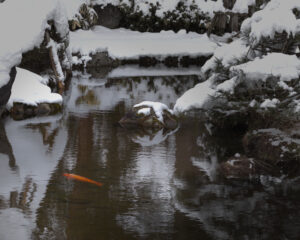As the leaves begin to turn and temperatures drop, it’s crucial for pond owners to prepare their aquatic havens for the winter months ahead. By following these essential fall pond care tips, you can ensure a healthy ecosystem for your fish and plants throughout the colder season.
- Don’t leave the leaves behind
Autumn’s beauty comes with a challenge: falling leaves. These can wreak havoc on your pond if left unchecked. Install a
pond net before the leaves start to fall. This simple step will save you hours of maintenance later. For those who didn’t use a net, don’t worry – a long-handled pond net can help you scoop out leaves from the bottom of your pond. Remember to check your skimmer basket regularly and remove any trapped debris.
- Trim and Relocate Plants
Now’s the time to trim back hardy marginal aquatic plants to about 2 inches above the water level. This prevents dead foliage from decomposing in the pond. For waterlilies, trim leaves and stems to 2-3 inches above the base. If you have hardy waterlilies in pots, relocate them to the deepest part of the pond for overwintering. Tropical varieties should be brought indoors or treated as annuals, as they’re challenging to overwinter successfully.
- Adjust Your Feeding Routine
As temperatures drop, your fish’s metabolism slows down. When water temperatures reach 50°F, it’s time to switch to a
cold weather fish food. These specialized foods are easier for fish to digest in cooler waters. Once temperatures dip below 50°F, stop feeding altogether. This allows your fish to prepare for hibernation without any metabolic complications.

- Maintain Water Quality
Falling temperatures don’t mean you can neglect water quality. Add
cold water beneficial bacteria to your pond when temperatures drop below 50°F. Use it twice weekly for two weeks, then once per week until the water begins to freeze. This helps break down organic matter and maintains a healthy ecosystem.Watch
FULL VIDEO about this best-selling water treatment for cooler weather
HERE!
- Keep the Water Moving
Installing a
pond aerator is crucial for maintaining oxygen levels in your pond during fall and winter. It prevents the water surface from freezing completely, allowing for gas exchange and keeping your fish healthy. Aerators also help circulate the warmer water from the bottom of the pond, preventing the formation of ice.
- Prepare for Winter
As winter approaches, consider investing in a pond
de-icer. While not necessary in all climates, it can be crucial in areas with harsh winters. A de-icer keeps a small area of the pond surface free from ice, allowing toxic gases to escape and oxygen to enter. By following these fall pond care tips, you’ll set the stage for a healthy, vibrant pond come spring. Remember, a little effort now saves a lot of work (and potential heartache) later. Happy ponding!
In need of some pond supplies? Check our PondMAX and Teton product lines, and when you’re read to order, visit our Dealer Locator to find a store near you: castleaquatics.com/dealer
Want to become an Authorized Dealer with Castle Aquatics? Click here to learn more!


